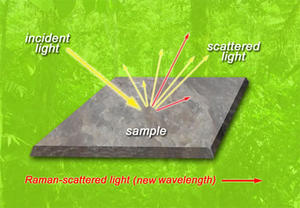In the trenchesBAE and Portendo join forces on IED detector
The device aims a laser beam at a particular area suspected to hide an IED; the reflected light is collected by the apparatus and is analyzed using a Raman scattering method, which provides a unique molecular signature which can be compared against an explosives database; Raman spectroscopy has long been thought to hold promise for such applications, but it typically provides a very weak signal; until now

Analysis of light reflected off a sample discloses the makeup of the material // Source: lbl.gov
A Swedish-developed security system that uses lasers to detect minute quantities of explosives may soon be providing British troops with an early warning of roadside bombs. Under an agreement with BAE Systems, the P.Eye system, designed by Swedish security firm Portendo, will be redeveloped by BAE to detect roadside bombs and IEDs.
The current system, which is about to enter production, is optimized for vehicle check points and airport security applications. Able to detect explosives from a range of around five meters, it works by aiming a laser beam at a particular area on the target vehicle.
The reflected light is collected by the apparatus and is analyzed using a Raman scattering method, which provides a unique molecular signature which can be compared against an explosives database. Though Raman spectroscopy has long been thought to hold promise for such applications, it typically provides a very weak signal.
According to BAE spokesman Mike Sweeney, Portendo has succeeded in cracking this challenge. “The ramen signal is very weak and tends to get lost in he background noise,” he explained. “Portendo has made a breakthrough, and that’s why we signed the deal.”
The next step is to develop the technology for military applications where, believes Sweeney, it could represent a major step forward in the fight against roadside bombs, which currently relies on human surveillance and surveillance from UAVS. “For that we’ll need to increase the range,” explained Sweeny, “the other challenge is to get it work in harsher environments. One particular issue we need to overcome is heat-haze.”
Sweeney said he expects a military version of the detector to be on the market within eighteen months. Although the civil version of the system will cost around €400,000, he declined to speculate on the cost of its military equivalent.
